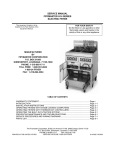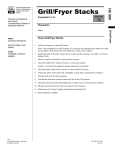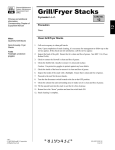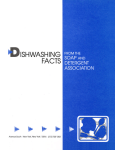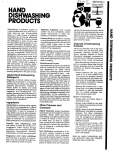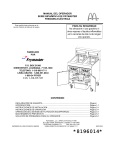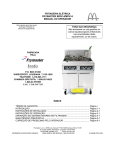Download Acer AO722-0473 Laptop User Manual
Transcript
OPERATOR’S MANUAL FRYMASTER BIH/MH14 SERIES ELECTRIC FRYER This equipment chapter is to be installed in the Fryer Section of the Equipment Manual. FOR YOUR SAFETY Do Not Store or use gasoline or other flammable vapors and liquids in the vicinity of this or any other appliance. MANUFACTURED BY P.O. BOX 51000 SHREVEPORT, LOUISIANA 71135-1000 PHONE: 1-318-865-1711 TOLL FREE: 1-800-551-8633 1-800-24 FRYER FAX: 1-318-219-7135 TABLE OF CONTENTS WARRANTY STATEMENT ..................................................................................................Page i INTRODUCTION ..................................................................................................................Page 1-1 INSTALLATION INSTRUCTIONS .......................................................................................Page 2-1 OPERATING FRYERS WITH THERMOSTAT CONTROLLERS ........................................Page 3-1 OPERATING THE BUILT-IN FILTRATION SYSTEM ..........................................................Page 4-1 PREVENTIVE MAINTENANCE AND TROUBLESHOOTING..............................................Page 5-1 Frymaster L.L.C., 8700 Line Avenue 71106 P.O. Box 51000, Shreveport, Louisiana 71135-1000 PHONE 318-865-1711 FAX 318-219-7135 PRINTED IN THE UNITED STATES SERVICE HOTLINE 1-800-24-FRYER 819-5569 08/2002 WARNING IMPROPER INSTALLATION, ADJUSTMENT, ALTERATION, SERVICE OR MAINTENANCE CAN CAUSE PROPERTY DAMAGE, INJURY OR DEATH. READ THE INSTALLATION, OPERATING AND MAINTENANCE INSTRUCTIONS THOROUGHLY BEFORE INSTALLING OR SERVICING THIS EQUIPMENT. WARNING FOR YOUR SAFETY, DO NOT STORE OR USE GASOLINE OR OTHER FLAMMABLE VAPORS AND LIQUIDS IN THE VICINITY OF THIS OR ANY OTHER APPLIANCE. COMPUTERS FCC This device complies with Part 15 of the FCC rules. Operation is subject to the following two conditions: 1)This device may not cause harmful interference, and 2) This device must accept any interference received, including interference that may cause undesired operation. While this device is a verified Class A device, it has been shown to meet the Class B limits CANADA This digital apparatus does not exceed the Class A or B limits for radio noise emissions as set out by the ICES-003 standard of the Canadian Department of Communications. Cet appareil numerique n'emet pas de bruits radioelectriques depassany les limites de classe a et b prescrites dans la norme NMB-003 edictee par le ministre des communications du Canada. WARNING THIS PRODUCT CONTAINS CHEMICALS KNOWN TO THE STATE OF CALIFORNIA TO CAUSE CANCER AND/OR BIRTH DEFECTS OR OTHER REPRODUCTIVE HARM. Operation, installation and servicing of this product could expose you to airborne particles of glasswool or ceramic fibers, crystalline silica, and/or carbon monoxide. Inhalation of airborne particles of glasswool or ceramic fibers is known to the State of California to cause cancer. Inhalation of carbon monoxide is known to the State of California to cause birth defects or other reproductive harm. FRYMASTER ELECTRIC FRYERS ARE MANUFACTURED FOR USE WITH THE TYPE VOLTAGE SPECIFIED ON THE FRYER RATING PLATE LOCATED ON THE FRYER DOOR. FOR PROPER INSTALLATION PROCEDURES IN THE UNITED STATES, REFER TO THE LATEST EDITION OF THE NATIONAL ELECTRIC CODE ANSI/N.F.P.A. NO. 70; IN CANADA, CANADIAN ELECTRICAL CODE PART 1, CSA-22.1. FOR INSTALLATION IN COUNTRIES OTHER THAN THE UNITED STATES AND CANADA, REFER TO THE NATIONAL CODE APPROPRIATE FOR THE COUNTRY IN WHICH THE EQUIPMENT IS BEING INSTALLED. INFORMATION ON THE CONSTRUCTION AND INSTALLATION OF VENTILATING HOODS MAY BE OBTAINED FROM THE LATEST EDITION OF THE "STANDARD FOR THE INSTALLATION OF EQUIPMENT FOR THE REMOVAL OF SMOKE AND GREASE LADEN VAPORS FROM COMMERCIAL COOKING EQUIPMENT,” N.F.P.A. NO. 96. COPIES OF THESE ELECTRICAL STANDARDS ARE AVAILABLE FROM THE NATIONAL FIRE PROTECTION ASSOCIATION, BATTERY MARCH PARK, QUINCY, MASS. 02269 WARRANTY STATEMENT Frymaster, L.L.C. makes the following limited warranties to the original purchaser only for this equipment and replacement parts: A. WARRANTY PROVISIONS - FRYERS 1. Frymaster L.L.C. warrants all components against defects in material and workmanship for a period of one year. 2. All parts, with the exception of the frypot, heating elements and fuses, are warranted for one year after installation date of fryer. 3. If any parts, except fuses, become defective during the first year after installation date, Frymaster will also pay straight-time labor costs to replace the part, plus up to 100 miles/160 km of travel (50 miles/80 km each way). B. WARRANTY PROVISIONS - FRYPOTS (Applies to fryers installed on or after January 1, 1995, only.) If a frypot develops a leak within seven years after installation, Frymaster will, at its option, either replace the entire battery or replace the frypot, allowing up to the maximum time per the Frymaster time allowance chart hours of straight-time labor plus up to 100 miles/160 km of travel (50 miles/80 km each way) to change the frypot. C. WARRANTY PROVISIONS - HEATING ELEMENTS (Applies to fryers installed on or after January 1, 1995, only.) 1. Frymaster L.L.C. warrants the heating elements against defective material or workmanship for a period of three years from the original installation date, parts only. 2. This warranty does not cover ancillary components, including the hi-limit, temperature probe, and contactors. D. WARRANTY PROVISIONS - COOKING COMPUTER 1. Frymaster L.L.C. warrants the M-2000 Cooking Computer against defective material or workmanship for a period of one year from the original installation date, parts and labor. Replacements for defective units during the second and third year are available at a reduced rate. 2. During this warranty period, Frymaster will, at its option, repair or replace defective cooking computer returned with new or factory rebuilt and functionally operative units. 3. For replacement of defective computers under warranty, call your local Frymaster Factory Authorized Service Center. All computers replaced under the Frymaster exchange program are covered by a one-year (parts only) warranty. i E. PARTS RETURN All defective in-warranty parts must be returned to a Frymaster Authorized Factory Service Center within 60 days for credit. After 60 days, no credit will be allowed. F. WARRANTY EXCLUSIONS This warranty does not cover equipment that has been damaged due to misuse, abuse, alteration, or accident such as: • improper or unauthorized repair (including any frypot which is welded in the field); • failure to follow proper installation instructions and/or scheduled maintenance procedures as prescribed in your MRC cards. Proof of scheduled maintenance is required to maintain the warranty; • improper maintenance; • damage in shipment; • abnormal use; • removal, alteration, or obliteration of either the rating plate or the date code on the heating elements; • operating the frypot without shortening or other liquid in the frypot; • no fryer will be warranted under the seven-year program for which a proper start-up form has not been received. This warranty also does not cover: • transportation or travel over 100 miles/160 km (50 miles/80 km each way), or travel over two hours; • overtime or holiday charges; • consequential damages (the cost of repairing or replacing other property which is damaged), loss of time, profits, use or any other incidental damages of any kind. There are no implied warranties of merchantability or fitness for any particular use or purpose. ii CHAPTER 1: INTRODUCTION 1.1 General Read the instructions in this manual thoroughly before attempting to operate this equipment. This manual covers all configurations of models MH14 and BIMH14 fryers built since September, 2001. Models designated MH14 do not have built-in filtration systems. Models designated BIH14 are equipped with FootPrint III built-in filtration systems. H14 Series fryers feature deep cold-zones and easy to clean, open frypots with tilt-up elements. The fryers are controlled by multi-product cooking computers or optional thermostat controllers. Fryers in this series come in full or split-pot arrangements, and can be purchased as single units or grouped in batteries of up to five fryers. 1.2 Safety Information Before attempting to operate your unit, read the instructions in this manual thoroughly. Throughout this manual, you will find notations enclosed in double-bordered boxes similar to the ones below. CAUTION CAUTION boxes contain information about actions or conditions that may cause or result in a malfunction of your system. WARNING WARNING boxes contain information about actions or conditions that may cause or result in damage to your system, and which may cause your system to malfunction. DANGER DANGER boxes contain information about actions or conditions that may cause or result in injury to personnel, and which may cause damage to your system and/or cause your system to malfunction. Fryers in this series are equipped with automatic safety features: 1. Two high temperature detection features shut off power to the elements should the controlling thermostat fail. 2. A safety switch built into the drain valve prevents the elements from heating with the drain valve even partially open. 1-1 1.3 Computer Information This equipment has been tested and found to comply with the limits for a Class A digital device, pursuant to Part 15 of the FCC rules. While this device is a verified Class A device, it has been shown to meet the Class B limits. These limits are designed to provide reasonable protection against harmful interference when the equipment is operated in a commercial environment. This equipment generates, uses and can radiate radio frequency energy and, if not installed and used in accordance with the instruction manual, may cause harmful interference to radio communications. Operation of the equipment in a residential area is likely to cause harmful interference in which case the user will be required to correct the interference at his own expense. The user is cautioned that any changes or modifications not expressly approved by the party responsible for compliance could void the user's authority to operate the equipment. If necessary, the user should consult the dealer or an experienced radio and television technician for additional suggestions. The user may find the following booklet prepared by the Federal Communications Commission helpful: "How to Identify and Resolve Radio-TV Interference Problems". This booklet is available from the U.S. Government Printing Office, Washington, DC 20402, Stock No. 004-000-00345-4. 1.4 Shipping Damage Claim Procedure What to do if your equipment arrives damaged: Please note that this equipment was carefully inspected and packed by skilled personnel before leaving the factory. The freight company assumes full responsibility for safe delivery upon acceptance of the equipment. 1. File Claim for Damages Immediately—Regardless of extent of damage. 2. Visible Loss or Damage—Be sure this is noted on the freight bill or express receipt and is signed by the person making the delivery. 3. Concealed Loss or Damage—If damage is unnoticed until equipment is unpacked, notify Freight Company or carrier immediately and file a concealed damage claim. This should be done within 15 days of date of delivery. Be sure to retain container for inspection. 1-2 1.5 Service Information McDonald’s store personnel perform routine maintenance. For non-routine maintenance or repairs, or for service information, contact your local Frymaster Authorized Service Center (FASC). Service information may also be obtained by calling the Frymaster Technical Services Department (1-80024FRYER). The following information will be needed in order to assist you efficiently: Model Number _________________________ Serial Number _________________________ Voltage _______________________________ Nature of the Problem ___________________ _____________________________________ _____________________________________ RETAIN AND STORE THIS MANUAL IN A SAFE PLACE FOR FUTURE USE. 1-3 CHAPTER 2: INSTALLATION INSTRUCTIONS 2.1 General Proper installation is essential for the safe, efficient, trouble-free operation of this appliance. Any unauthorized alteration of this equipment will void the Frymaster warranty. DANGER Copper wire suitable for at least 167° F (75° C) MUST be used for power connections. DANGER The electrical power supply for this appliance MUST be the same as indicated on the rating and serial number plate located on the inside of the fryer door. DANGER This appliance MUST be connected to the voltage and phase as specified on the rating and serial number plate located on the inside of the fryer door. DANGER All wiring connections for this appliance MUST be made in accordance with the wiring diagrams furnished with the equipment. Wiring diagrams are located on the inside of the fryer door. DANGER Do not store or use gasoline or other flammable vapors and liquids in the vicinity of this or any other appliance. In the event of a power failure, the fryer(s) will automatically shut down. If this occurs, turn the power switch OFF. Do not attempt to start the fryer(s) until power is restored. This appliance must be kept free and clear of combustible material, except that it may be installed on combustible floors. A clearance of 6 inches (15cm) must be provided at both sides and back adjacent to combustible construction. A minimum of 24 inches (61cm) should be provided at the front of the equipment for servicing and proper operation. WARNING Do not block the area around the base or under the fryers. The duct system, the hood, and the filter bank must be cleaned on a regular basis and kept free of grease. See the appropriate Maintenance Requirement Cards. 2–1 2.2 After Fryers Are Under The Fry Station Hood Adjust casters so that fryers are level and at the proper height in the fry station hood. If necessary, level the fryer(s) by loosening the locking screw on the caster leg and screwing the caster in or out. When fryer is level and at proper height, retighten the locking screw on the caster leg. Secure the fryer in place under the hood with the restraining hardware installed with the hood. 2.3 Power Requirements DANGER Copper wire suitable for at least 167°F (75°C) MUST be used for power connections. MODEL H14 H14 H14 H14 H14 H14 ALL 14 SERIES EPRI UNITS VOLTAGE PHASE 208 240 480 220/380 240/415 230/400 208 240 220/380 240/415 3 3 3 3 3 3 3 3 3 3 WIRE SERVICE MIN. SIZE 3 3 3 4 4 4 3 3 4 4 6 6 8 6 6 6 6 6 6 6 AWG (mm2) (16) (16) (10) (16) (16) (16) (16) (16) (16) (16) AMPS PER LEG L1 L2 L3 39 34 17 21 20 21 39 34 21 20 39 34 17 21 20 21 39 34 21 20 39 34 17 21 21 21 39 34 21 20 DANGER The electrical power supply for this appliance MUST be the same as indicated on the rating and serial number plate located on the inside of the fryer door. DANGER This appliance MUST be connected to the voltage and phase as specified on the rating and serial-number plate located on the inside of the fryer door. DANGER All wiring connections for this appliance MUST be made in accordance with the wiring diagrams furnished with the equipment. Wiring diagrams are located on the inside of the fryer door. 2–2 2.4 Frypot Boil-Out Before the fryer is first used for cooking product, it should be boiled out to ensure that any residue from the manufacturing process has been completely eliminated. Also, after the fryer has been in use for a period of time, a hard film of caramelized vegetable oil will form on the inside of the frypot. This film should be periodically removed by following the boil-out procedure. Refer to Fryers Maintenance Requirement Card (MRC) 14A for the boil-out procedure. 2–3 CHAPTER 3: OPERATING FRYERS WITH ANALOG CONTROLLERS 3.1 Equipment Setup and Shutdown Procedures Setup WARNING Fill the frypot to the bottom oil level line with oil before pressing the power switch to the ON position. Failure to do so could damage the frypot. Fill the frypot with oil to the bottom OIL LEVEL line located on the rear of the frypot. This will allow for oil expansion as heat is applied. Do not fill cold oil any higher than the bottom line; overflow may occur as heat expands the oil. Ensure that the power cord(s) is/are plugged into the appropriate receptacle(s). Verify that the face of the plug is flush with the outlet plate, with no portion of the prongs visible. Set the thermostat knob to the desired frying temperature. Ensure that the oil level is at the top OIL LEVEL line when it is at its intended cooking temperature. It may be necessary to add oil to bring it up to the proper level. Shutdown 1. Press the POWER switch to the "OFF" position (the POWER light will go out). 2. Filter oil and clean fryers. 3. Place the frypot covers on the frypots. For computer operating instructions, see separate computer manual, 819-5833 that came with the computer. 3.2 Introduction to the Analog Controller The analog controller, illustrated on the following page, is used to adjust and maintain oil at the temperature indicated by the thermostat knob. The fryer has two built-in high-limit protection features. If the temperature in the frypot reaches approximately 410°F (210°C), the computer opens the heat relay circuit, turning the elements off. If the temperature in the frypot reaches 450°F (232°C), a mechanical high-limit shuts off electrical power to the elements. The operator should periodically test each of the high-limit protection features to verify that they are operating correctly. Refer to page 3-3, Analog Controller High-Limit Check, or the Grills/Fryers Maintenance Requirement Card (MRC) 15 for the procedure. The analog controller has no timing features. Shake, pull, and QA (hold) times must be monitored by the operator. 3-1 M E G HEAT TROUBLE POWER SECOND 280 SECOND POWER 2ND 0 12 240 110 0 10 120 110 0 10 220 1ST 0 0 19 20 0 I 1ST K L ON POWER o C o F 360 F 150 180 o 140 170 C 360 o 0 13 340 HI-LIMIT TEST 180 OFF 2ND 20 150 300 0 16 240 HEAT 0 32 140 170 220 TROUBLE 280 340 POWER 0 13 F 0 26 0 16 ON D H 300 0 32 0 26 A N 0 19 C J OFF B SPLIT VAT CONTROLLER ILLUSTRATED FULL VAT CONTROLLER HAS ONLY LEFT SET OF CONTROLS ITEM DESCRIPTION A Power Switch, Left or Full-Vat - Controls electrical power to fryer. B Power Switch, Right Vat - Controls electrical power to fryer. C Power-On Light, Left or Full-Vat - Indicates when electrical power to fryer is ON. D Power-On Light, Right Vat - Indicates when electrical power to fryer is ON. E Heating Mode Light, Left or Full-Vat - Indicates when heating element is ON. F Heating Mode Light, Right Vat - Indicates when heating element is ON. G Trouble Light, Left or Full-Vat - Indicates over high-limit or problem in heat control circuitry. H Trouble Light, Right Vat - Indicates over high-limit or problem in heat control circuitry. I Thermostat Control Knob, Left or Full-Vat - Sets desired frying temperature. J Thermostat Control Knob, Right Vat - Sets desired frying temperature. K Hi-Limit Test Switch, Left or Full-Vat - Tests high-limit thermostat for left vat (or full-vat). L Hi-Limit Test Switch, Right Vat - Tests high-limit thermostat for right vat. M Second Hi-Limit Test Light, Left or Full-Vat - Indicates fryer is in second high-limit test mode. N Second Hi-Limit Test Light, Right Vat - Indicates fryer is in second high-limit test mode. 3-2 3.3 Analog Controller Operating Instructions WARNING Before pressing the power switch to the ON position, ensure that the frypot is properly filled with oil. See Section 3.1. 1. Verify that the thermostat knob is set to the desired cooking temperature. For split-vat units, set both knobs. 2. Press the power switch to the ON position. The POWER light will illuminate. For split-vat units, both power switches must be placed in the ON position if both vats are to be used. 3. If the frypot temperature is below 180°F (82°C), the controller will automatically enter a warm-up cycle (often called a melt cycle). The heating elements will cycle on and off repeatedly, allowing the oil to heat gradually, without scorching. During the warm-up cycle, the heating mode light will alternately illuminate and go off as the elements cycle on and off. Within about 45 minutes, the controller will exit the warm-up cycle and the heating mode light will remain continuously illuminated. 4. When the oil temperature reaches the thermostat knob setpoint, the elements will cycle OFF and the heating mode light will go off, indicating that the fryer is ready for the cooking process to begin. 3-3 CHAPTER 4: OPERATING THE BUILT-IN FILTRATION SYSTEM (BIH14 SERIES ONLY) 5 1 ITEM 1 2 3 * 4 * 5 6 7 2 DESCRIPTION Filter Base Assembly Filter Pan Assembly Filter Paper Hold-down Ring O-ring, Filter Pan Pan Cover Screw, Pan Cover Hinge Filter Base Handle Filter Paper Screen Crumb Screen 3 4 6 7 FUNCTION Housing for filter pan. Collects oil during filtering process. Secures filter paper or pad in place. Seals pan suction line. Covers filter pan assembly. Attaches pan cover to filter pan. Means to pull filter assembly from fryer. Fits under filter paper/pad to allow passage of oil when filtering. Collects heavy breading when draining oil into filter pan. * Not Illustrated 4-1 4.1 STEP-BY-STEP FILTRATION INSTRUCTIONS Switch computer to OFF. Slide the filter pan from the fryer cabinet. Open the filter-cover, and remove and clean the crumb tray. Note: The fryer must be at operating temperature prior to filtering. Remove and clean the hold-down ring. Remove and discard the dirty paper or pad. Remove and clean the filter screen. Make sure the inside of the pan is free of all food and breading particles that could prevent the screen from sealing against the bottom of the pan. Replace the filter screen in the bottom of the pan. Proper operation of the filter system depends upon proper placement of the filter screen. Never filter with the screen alone. 4-2 INCORRECT The filter pad is placed in the pan with the heavily textured side facing up. When filter paper is used, one sheet is placed over the screen and 8-ounces of filter powder is spread evenly on the top of the paper. WARNING: Do Not Use Filter Powder on Filter Pads CORRECT Place pad evenly on filter screen. If paper is used, position the paper on top of the pan with the edges evenly overlapping. Ensure that the screen is in place prior to pad or paper placement. Install hold-down ring over pad, or use ring to push filter paper to the bottom of the pan. Push down firmly to properly seat the paper/pad. 4-3 Use 8-ounces of filter powder and spread it evenly over filter paper. Remember, DO NOT USE filter powder on filter pads. Replace crumb screen inside the filter pan. It's imperative that the crumb screen is installed prior to filtering, for optimum filtersystem performance. Slide the filter pan back inside fryer cabinet. Important: Filter oil at operating temperature. Filtering at the end of the day ensures that the oil is at proper temperature. Locate the oil-return handle and the drainvalve handle. Drain Valve Handle Oil-Return Handle With fryer off, open drain valve. 4-4 When frypot empties into filter pan, turn return handle to ON. Filter pump will activate. The oil moves through the filter, the frypot and out the open frypot-drain during filtering. Allow the oil to circulate through the pot for 5 minutes. This process is called polishing the oil. Polishing cleans the oil and washes small particles from the frypot. Close the drain-valve and leave the filter pump on. With the drain-valve closed, the frypot fills with oil. 4-5 When the filter pan empties, bubbles will form in the frypot. Allow bubbling to continue 15-20 seconds to ensure the oil return lines are clear of residual oil. Turn off filter pump. Top up oil level. Some oil may be lost in filtering process. Fill to top mark (arrow) in frypot. Remember, the oil is at operating temperature. 4-6 The oil may drop below operating temperature during the filtering process. In that case, the fryer will display LowTemp and heat the oil when the computer is turned back on. Return fryer to operation, or filter another frypot in the battery. Remember, only one frypot can be filtered at a time. 4.2 CARE AND CLEANING OF YOUR FRYER AND FILTER SYSTEM WARNING: Never operate the fryer or filter system without oil in the system. Filter oil as often as needed. If a heavy volume of breaded food is fried, filter as often as every hour. Filtering often increases the life of the oil and produces a better-tasting product. The best rule to follow is to "filter before you think it is needed". Even with a product such as french fries, you should filter two to three times per day for best results. Periodically clean the frypot. Cleaning the frypot, combined with disposing of old oil enhances the flavor of the food product. Follow these steps when cleaning the frypot: 1. Turn the fryer power switch to the "OFF" position. Screw the drainpipe (provided with your fryer) into the drain valve. Make sure the drainpipe is firmly screwed into the drain valve and that the opening is pointing down. 2. Position a metal container with a sealing cover under the drainpipe. The metal container must be able to withstand the heat of the cooking oil/shortening and hold hot liquids. If you intend to reuse the oil or shortening, Frymaster recommends that a Frymaster filter cone holder and filter cone be used when a filter machine is not available. If you are using a Frymaster filter cone holder, be sure that the cone holder rests securely on the metal container. 3. Open the drain valve slowly to avoid splattering. If the drain valve becomes clogged with food particles, use the Fryer’s Friend (clean-out rod) to clear the blockage. DANGER DO NOT insert anything into the drain from the front to unclog the valve. Hot oil/shortening will rush out, creating an extreme hazard. 4-7 WARNING DO NOT hammer on the drain valve with the Fryer’s Friend. This will damage the drain valve ball and prevent the valve from sealing securely, resulting in a leaky valve. 4. After draining the oil/shortening, clean all food particles and residual oil/shortening from the frypot. BE CAREFUL, this material may still cause severe burns if it comes in contact with bare skin. 5. After the fryer is empty, drain the frypot and close the drain valve. Fill the frypot to the bottom OIL LEVEL line with water and the correct amount of McD All Purpose Concentrate (APC) Cleaner HSC. Place the baskets into the frypot and bring the solution to a simmer at 195° F (91° C) for 1 hour. Turn OFF the fryer, drain the solution into a metal stockpot and wipe the frypot clean and dry. NOTE: Do not drain water into the filter pan. Water will damage the filter pump enough to require replacement. Use a metal stockpot. 6. The filter pan and filter base assembly must be cleaned on initial start-up and periodically thereafter. a. To clean the filter pan, lift pan from the filter base. Take the filter pan to a sink filled with warm water and grease-cutting detergent. b. Scrub the filter pan with the frypot brush shipped with the fryer. c. Rinse the filter pan thoroughly to remove the detergent. Wipe dry with a clean, dry cloth or paper towels. d. To clean the filter base assembly, use a sponge or cloth soaked with a water and greasecutting solution. Be careful not to get water on the pump/motor assembly. e. Wipe the filter-base assembly with a clean, dry cloth or paper towel until dry. CAUTION All water MUST be removed from the suction tube before inserting filter pan. f. Wipe the inside and outside of the tube with clean, dry cloths or paper towels. g. Insert filter pan into the filter base assembly. 4-8 NOTE: To drain old oil or boil-out solution, drain in an appropriate container. DO NOT DRAIN WATER IN THE FILTER PAN. WARNING The filter pan MUST never be used to dispose of, or transport spent-cooking oil to the disposal area. Cooking oil MUST always be allowed to cool below 100°F (38°C) before transporting to the disposal area. An oil disposal unit (MSDU) is available and highly recommended for safety. DANGER Hot cooking-oil is dangerous and will cause severe burns. Handle with extreme caution. When discarding old cooking oil, drain from the fryer into an Oil Disposal Unit (MSDU50) - available from your local distributor. The disposal unit should be taken to the disposal site and the old cooking oil pumped into the grease storage container for proper disposal. 4-9 CHAPTER 5: PREVENTIVE MAINTENANCE AND TROUBLESHOOTING 5.1 Preventive Maintenance Preventive Maintenance (PM) procedures are contained in McDonald’s Preventive Maintenance System Maintenance Requirement Cards (MRC) 12, 14, 14A, and 15. The cards are distributed with this manual, but are not an integral part of the manual. A replacement card set may be ordered using part number 819-5432. To order both the card set and the Operator’s Manual, use part number 8195569. To order both the card set and the Service Manual, use part number 819-5625. In addition to maintenance referenced in MRC cards, Frymaster recommends that the fryer be inspected at least annually by a Factory Authorized Service Technician as follows: • Inspect the cabinet inside and out, front and rear for excessive oil build-up and/or oil migration. • Verify that the heating element wires are in good condition and that leads have no visible fraying or insulation damage and that they are free of oil migration build-up. • Verify that heating elements are in good condition with no carbon/caramelized oil build-up. Inspect the elements for signs of extensive dry-firing. • Verify that the tilt mechanism is working properly when lifting and lowering elements, and that the element wires are not binding and/or chafing. • Verify the heating-element amp-draw is within the allowed range as indicated on the appliance’s rating plate. • Verify that the temperature and high-limit probes are properly connected, tightened and functioning properly, and that mounting hardware and probe guard are present and properly installed. • Verify that component box and contactor box components (i.e. computer/controller, relays, interface boards, transformers, contactors, etc.) are in good condition and free from oil migration build-up and other debris. • Verify that component box and contactor box wiring connections are tight and that wiring is in good condition. • Verify that all safety features (i.e. contactor shields, drain safety switches, reset switches, etc.) are present and functioning properly. • Verify that the frypot/cookpot is in good condition and free of leaks and that the frypot/cookpot insulation is in serviceable condition. • Verify that all wiring harnesses and connections are tight and in good condition. • Inspect all oil-return and drain lines for leaks and verify that all connections are tight. 5-1 • Inspect the filter pan for leaks and cleanliness. If there is a large accumulation of crumbs in the crumb basket, advise the owner/operator that the crumb basket should be emptied into a fireproof container and cleaned daily. • Verify that all O-rings and seals (including those on the Power Shower and on quick-disconnect fittings) are present and in good condition. Replace o-rings and seals if worn or damaged. • Check filtration system integrity as follows: − With the filter pan empty, place each oil return handle, one at a time, in the ON position. Verify that the pump activates and that bubbles appear in the cooking oil/shortening (or that gurgling is heard from the Power Shower port) of the associated frypot. − Close all oil return valves (i.e., place all oil return handles in the OFF position). Verify proper functioning of each oil return valve by activating the filter pump using the lever on one of the oil return handle microswitches. No air bubbles should be visible in any frypot (or no gurgling should be heard from the Power Shower ports). − Verify that the filter pan is properly prepared for filtering, then drain a frypot of oil heated to 350°F (177°C) into the filter pan and close the frypot drain valve. Place the oil return handle in the ON position. Allow all cooking oil/shortening to return to the frypot (indicated by bubbles in the cooking oil/shortening or, on units with Power Showers, cessation of oil flow from the Power Shower). Return the oil return handle to the OFF position. The frypot should have refilled in no more than 2 minutes and 30 seconds. 5.2 Fryer Troubleshooting Below are simple checks that should be performed before contacting the FASC: ♦ Is the ON/OFF switch in the ON position? ♦ Is the drain valve completely closed? ♦ Is the face of the fryer’s power plug flush with the outlet plate (i.e., no part of the prongs visible)? ♦ Is the circuit breaker set in the ON position and are fuses OK? ♦ Is the computer display blank? Check the hood cord (small cord), ensuring it is pushed fully into the socket. Also check the ANSUL/hood system. ♦ Does the display show ignition failure? If so, turn off the fryer, open the drain valve slightly then close it. Attempt to operate the fryer. ♦ Does the fryer remain below setpoint temperature? If so, verify that the face of the plug is flush with the outlet plate (i.e., no part of the prongs visible). Also check the circuit breaker. ♦ Does the computer display on a split-vat unit show ignition failure? If so, turn off both vats. Turn on the one that displayed ignition failure first, then turn on the other vat. 5-2 5.3 Troubleshooting Built-in Filtration Systems (BIH Series Only) This section provides an easy reference guide to some of the common problems that may occur during the operation of built-in filtration systems. The troubleshooting tables that follow are intended to help correct, or at least accurately diagnose, problems with this equipment. Although the chapter covers the most common problems reported, you may encounter problems that are not covered. In such instances, the Frymaster Technical Services staff will make every effort to help you identify and resolve the problem. The BIH/MH14 Service manual (819-5625) contains more detailed troubleshooting procedures for the fryer and the filtration system, which should always be performed by a trained service technician. When troubleshooting a problem, always use a process of elimination starting with the simplest solution and working through to the most complex. Never overlook the obvious – anyone can forget to plug in a cord or fail to close a valve completely. Most importantly, always try to establish a clear idea of why a problem has occurred. Part of any corrective action involves taking steps to ensure that it doesn’t happen again. If a controller malfunctions because of a poor connection, check all other connections, too. If a fuse continues to blow, find out why. Always keep in mind that failure of a small component may often be indicative of potential failure or incorrect functioning of a more important component or system. Before calling a service agent or the Frymaster HOTLINE (1-800-24FRYER): • Verify that electrical cords are securely plugged in. • Verify that circuit breakers are on. • Verify that frypot drain valves are fully closed. DANGER Never attempt to move a fryer containing hot cooking oil or to transfer hot cooking oil from one container to another. DANGER Use extreme care when testing electrical circuits. Live circuits will be exposed. WARNING Inspection, testing, and repair of electrical equipment should be performed only by qualified service personnel. The equipment should be unplugged when servicing, except when electrical tests are required. 5-3 PROBLEM PROBABLE CAUSES CORRECTIVE ACTION A. If the pump runs normally after resetting the thermal overload switch, the pump was overheated. A. Thermal overload switch has tripped on an overheated motor. Test: If the pump stopped suddenly during the filtering process, especially if after several filtering cycles, the pump motor has probably overheated. Place the filter handle in the OFF position, allow the pump to cool for at least 45 minutes, and then press the reset button on the pump motor. Attempt to activate the pump. Always filter with the cooking oil/shortening at or near frying temperature. Allow the pump motor to cool off for about ten minutes after filtering two full frypots one after the other. Check the filter paper between filterings. Replace the paper if there is a large accumulation of sediment. B. Failed filter-handle microswitch. Pump won’t start. OR Pump stops during filtering. Test: If this is a multi-pot fryer, attempt to operate the pump using a B. If the switch is loose, tighten the nuts different handle. If the pump starts, and bolts holding it in place, ensuring the handle microswitch is either out that when the handle is placed in the of alignment or has failed. ON position, the lever on the microswitch is pressed firmly against When the handle is placed in the ON the switch. position, the lever on the microswitch should be firmly pressed against the If the switch has failed, call FASC. switch. If so, the switch has failed. If not, the switch is loose and/or misaligned. C. Pump blockage. Test: Close the drain valve. Place the filter handle in the OFF position, allow the pump to cool for at least 45 minutes, and then press the reset button on the pump motor. Pull the filter pan from the unit and then activate the pump. If the pump motor hums and then stops, the pump is blocked. 5-4 C. Pump blockages are usually caused by sediment build-up in the pump due to improperly sized or installed filter paper and failure to use the crumb screen. Call FASC to have blockage cleared. Ensure that filter paper is of the proper size and is installed properly, and that the crumb screen is used. A. To properly filter, the oil or shortening should be at or near 350°F (177°C). At temperatures lower than this, the oil/shortening becomes too thick to pass through the filter medium easily, A. Cooking oil/shortening is too cold for resulting in much slower oil return filtering. and eventual overheating of the filter pump motor. Ensure that the cooking oil/shortening is at or near frying temperature before draining into filter pan. B. Improperly installed or prepared filter pan components. B. Remove the oil from the filter pan and replace the filter paper, ensuring Test: Close the drain valve. Move the filter handle to the OFF position, that the filter screen is in place under pull the filter pan (and Power the paper. Shower, if so equipped) from the Pump starts, but no If this does not correct the problem, unit. Move the filter handle to the ON transfer takes place or the filter tube suction tube is probably position. the transfer is very blocked. Remove the blockage using slow. If a strong stream of air is being a thin, flexible wire. If unable to remove the blockage, call FASC. pumped out of the oil return port (or the Power Shower port), the problem is with the filter pan components. C. Improperly installed or prepared filter pan components. C. Verify that filter connection o-rings are present and in good condition. Test: Close the drain valve. Move the filter handle to the OFF position, Replace the filter paper, ensuring and pull the filter pan (and Power that the filter screen is properly Shower, if so equipped) from the positioned under the paper. unit. Move the filter handle to the ON position. If using Magnasol filter assembly, verify that o-ring is present and in If a strong stream of air is being good condition on filter screen fitting. pumped out of the oil return port (or the Power Shower port), the problem is with the filter pan components. 5-5



























